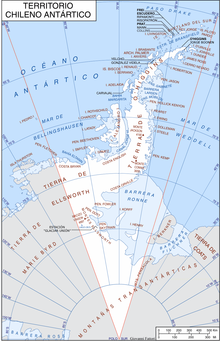| Magallanes and Antartica Chilena Region XII Región de Magallanes y de la Antártica Chilena | |||
|---|---|---|---|
| — Region of Chile — | |||
| |||
| Map of Magallanes and Antartica Chilena Region | |||
| Country | Chile | ||
| Capital | Punta Arenas, Chile | ||
| Provinces | Magallanes, Antártica Chilena, Tierra del Fuego, Última Esperanza | ||
| Government | |||
| - Intendant | Mario Maturana Jaman | ||
| Area[1] | |||
| - Total | 132,297.2 km2 (51,080.2 sq mi) | ||
| Area rank | 1 | ||
| Lowest elevation | 0 m (0 ft) | ||
| Population (2002)[1] | |||
| - Total | 150,826 | ||
| - Rank | 14 | ||
| - Density | 1.1/km2 (3/sq mi) | ||
| ISO 3166 code | CL-MA | ||
The XII Magallanes and Antártica Chilena Region (Spanish: XII Región de Magallanes y de la Antártica Chilena, literally in Spanish: Region of Magellan and Chilean Antarctica) is one of Chile's 15 first order administrative divisions. It is the southernmost, largest and second least populated region of Chile.
This region has many globally known places and geographical features including Torres del Paine, Cape Horn, Tierra del Fuego island, and the Strait of Magellan. It also includes the Antarctic territory claimed by Chile.

The main economic activities are bovine farming, oil extraction and tourism. This region is also home of the Patagonian Expedition Race.[2]
Contents[hide] |
[edit] Geography
This region contains mountainous peaks and glaciers in the far north, including elements of the Patagonian Ice Sheet. Further south there are other mountain ranges such as the Cerro Toro and numerous surface waters including the Seno Última Esperanza, Eberhard Fjord and Lago Grey. Protected areas include the Torres del Paine National Park and the Cueva del Milodon Natural Monument, at the latter of which have been discovered remains of the extinct Giant Sloth as well as of prehistoric man dating to circa 10,000 BC.[3]
[edit] Demographics
The population of the region is one of the lowest in Chile, as one of the last regions colonized and populated.
In the 1854 census counted 158 settlers, who belonged to the people of Punta Arenas, the native population, according to King, amounted in 1830, approximately 2,200 (about 400 in western Patagonia and south approximately 1,600 Strait).
The census of 1875 was aware of 1,144 inhabitants and in 1895 the population had risen to 5170 inhabitants, mostly concentrated in the city of Punta Arenas and its surroundings.
The installation of the cattle ranches attracted people from Europe (mostly Croatians, British, Swiss and Italian) and southern Chile (mostly Chiloé), which greatly increased the population of the region.
Punta Arenas is said to have the largest percentage of Croatians in the world outside Croatia and the former Yugoslavia. There is a higher proportion of non-Spanish Europeans there as well (esp. Scots and Greeks), and descendants of Germans, Dutch, Danes and other Scandinavians, Russians and Portuguese peoples.
From the late 18th century to the opening of the Panama Canal in 1914, thousands of trans-oceanic voyages stopped by Punta Arenas as the most convenient strait between the Atlantic and Pacific oceans. The settlement of Punta Arenas and the Magallanes region is a result of its' past being a hub to international travel.
Already in the 1907 census, the Territory of Magallanes had 17,330 inhabitants, distributed as follows: - City of Punta Arenas: 12,785 hab. - Patagonia Chilena: 1,094 hab. - Pen. of Brunswick: 1062 hab. - Tierra del Fuego: 1626 hab. - Beagle Channel: 184 inhabitants. - Last Hope: 392 inhabitants. - Baker River: 187 inhabitants.
This proportion has remained until our days to focus the bulk of the regional population in the city of Punta Arenas, and in the provincial capital Puerto Natales, Porvenir (Spanish for "future") and Puerto Williams, one of the world's southernmost cities.
In the past 50 years the population has maintained a moderate increase, as shown below, keeping one of the lowest population densities in the country and since this is mostly urban, mostly concentrated in Punta Arenas.
- Census
- 1952: 55,206 hab.
- 1960: 73,358 hab.
- 1970: 89,443 hab.
- 1982: 131,914 hab.
- 1992: 143,198 hab.
- 2002: 150,826 hab.
The most populated cities (2002 census) are: Punta Arenas (116,005 inhab.), Puerto Natales (16,978 hab.) Porvenir (4734 pop.), Puerto Williams (1952 pop.), and Cerro Sombrero (687 pop.).







No comments:
Post a Comment